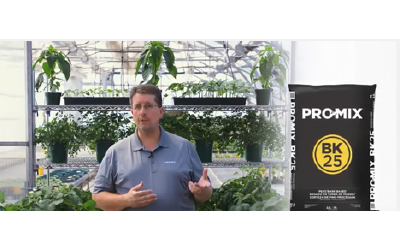D.I.G. Conference: Tips on How to set up PGR Trials
This past October, Dr. James Gibson from Syngenta Flowers gave a talk about proper plant growth regulator (PGR) trials and what tips he recommends for beginners at the AmericanHort DIG Conference. Here is what he had to say.
“It all starts with a cart” Gibson says.
Carts used to move plants from greenhouses to retail stores can be used to measure what your goal is for a PGR trial.
“Wholesale production control standards for total height and canopy are usually 20% to 35% shorter plants,” Gibson says. “And plant diameter wholesale standards normally range from 15% to 20% smaller plants, when compared to untreated plants.”
Retail growers may stick to the low end at 20% to 25% total height as there is less travel involved from greenhouse to market, according to Gibson.
When Would You Need to Start a Trial for Yourself
“Let’s not reinvent the wheel” Gibson says.
Check out your resources. Resources like articles on previous trials for a specific crop and their results, product information guides and success guides from the companies and online calculators can help you.
Trials should be done for more specific challenges to you and what you are growing.
Challenges like how hardy is this specific crop, how does this chemistry work in my current environment, and how can I grow this in a specific time window are when it would be best to do a trial. If a retailer also requires a specific spec (i.e. specific height or diameter) this is when a trial would be necessary for a grower to conduct.
Types of Applications and Techniques
PGRs have many different applications and protocols that can be done, and they depend on how far along a plant is.
For young plants, Gibson recommends media sprays, media sprenches, linear or plug sprays or drenches, and linear dips. For finished plants spray to run-off or sprenches and a drench for finishing and holding work great.
Tips for Successful Trials
PGR trials do best when you follow the label, Gibson says. The label gives pertinent information when it comes to what chemistry is recommended for your trials.
“We would never recommend you use used trays,” Gibson says. “Because old product can stick to the plastic and that can impact data.”
“You want to be using sprays as a volume by area, so you are not just spraying the tray and the foliage,” says Gibson. “You also want to keep in mind the time of day you are applying these PGRs.”
PGR trials are best done with 50% moisture status (or at about stage 3). Gibson describes 50% moisture status as “if you squeeze the media, and you may see a bit of moisture between your fingers.”
“You always want to have an untreated control,” says Gibson. “But from an academic standpoint you can still spray [the control] with water at the same concentrations as the other plants to keep things consistent.”
“The most critical rules of thumb when it comes to PGR trials is when you are spraying a half a gallon per 100 square feet, [that] is where you will see spray to runoff,” says Gibson.
Drenches are also useful for PGR. Things to keep in mind, according to Dr. Gibson, are that as the plant container increases the volume of drench required increases usually. Drenches, however, must be properly calibrated as to not cause a PGR overdose.
Tools You May Want to Invest in
Here are a list of tools Dr. Gibson recommends for all PGR trials:
- Multiple 1.5-to-2-liter spray bottles for different chemicals
- Personal Protective Equipment (PPE)
- Plastic syringes
- Measuring cups
- 3-gallon sprayer
- Graduated devices
- Beakers
- Buckets
- Mixing rods
- Colored flags and tags for labeling










